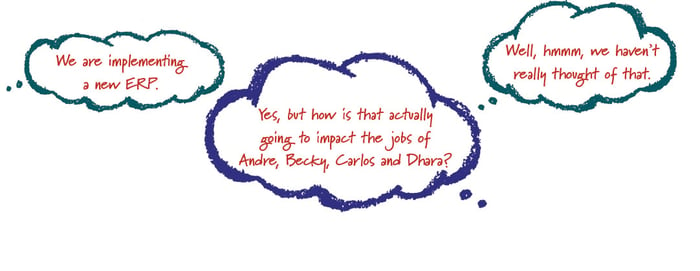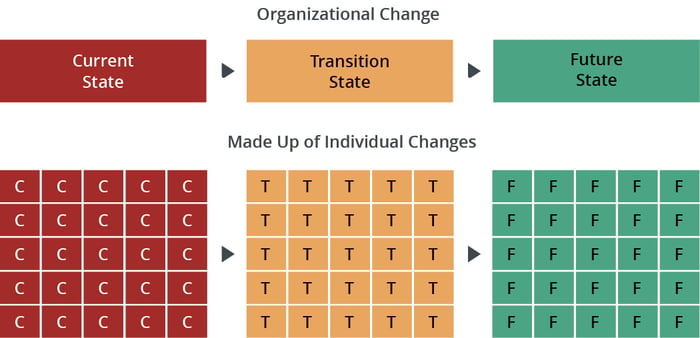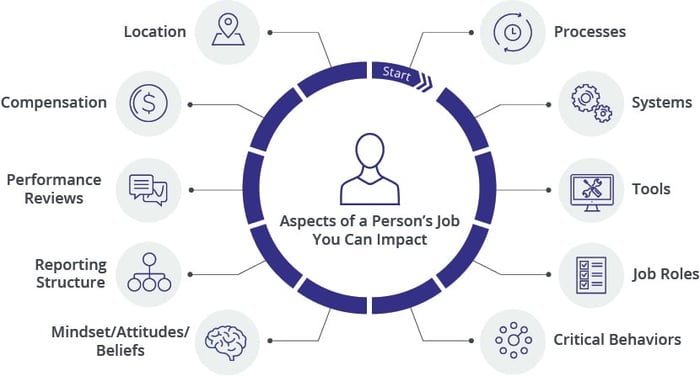One of the biggest challenges that change practitioners face is translating an organizational-level change (“We are implementing a new enterprise resource planning application”) to the individual level (“How the change is brought to life in the day-to-day jobs of Andre, Becky, Carlos and Dhara.”)
It’s a VUCA world (volatile, uncertain, complex and ambiguous). The pace and structure of our lives and the business world today is fast and continually moving. A change practitioner faced with bigger, faster and more complex change is challenged by the volume, and it becomes very easy to either forget, ignore or get lazy about managing change down to that individual level where it happens.

Bringing Change Impact Into Focus
Our hope is that this frame—Prosci’s 10 Aspects of Change Impact—is going to equip you to do that, because then you’ll start to surface those issues that we often miss and are a critical success factor in enabling change. How often are the architects of the latest system deployment in your organization talking about the impact the technology has on the daily lives of Andre, Becky, Carlos and Dhara?

We know that the achievements of the organization are the results of the combined effort of all the individuals that make up that organization. So, if you focus only at the enterprise level when you implement change, you risk losing people along the way. They can stay stuck where they are and never step out of the current state; it’s likely that they will not make that personal transition successfully.
If we can’t get people to the future state and help them stay there, they can regress back to the way they used to do things and we end up with a compromised future state—made up of incomplete individual journeys—and we don't realize the expected value. Furthermore, we create consternation and resistance. Structured change management provides a way to close the gap to ensure that the future state we envisioned is what we arrive at because we brought each of our employees along on that journey.

10 Aspects of Change Impact Model
What is needed is a framework that enables change practitioners to remind, focus, dissect and document the individual’s journey. Prosci addressed this several years ago by introducing the 10 Aspects of Change Impact model.
In creating this model, we took a step back and imagined that we were rolling out a new CRM or ERP, engaged in a post-merger acquisition, or launching a new product, and then considered how it impacts an individual in their job. What are the aspects of how someone shows up each day that your change may or may not impact?
That's where we get the 10 aspects: processes, systems, tools, job roles, critical behaviors, mindsets/attitudes/beliefs, reporting structure, performance reviews, compensation and location. This is a deceivingly simple but profoundly helpful list of facets present in times of change.

Now, your initiative may or may not impact these 10 aspects of how somebody shows up each day in their job. But you won't know until you start to ask and think about it and define change impact at that individual level.
The other thing that this does right out of the gate is helps us understand that a change impacts different groups differently. A change that impacts one group only marginally might completely disrupt another group within the organization. These 10 aspects and the framework of focusing on change impact at the individual level help us to start to make sense of how change comes to life across our organization.
Name It to Tame It
We tend to live at 30,000 feet, but change happens at 300 feet. Our job as change practitioners is to close that gap to take an enterprise-level transformation and boil it down into the individual change impacts. If we want to demonstrate empathy for our stakeholders, build adoption metrics, or help our colleagues manage change, we need a model to empower us so that we have this mindset from the start.
You can leverage this list in a variety of ways. The most basic is to list the “10 Aspects” down the left column of a two-column worksheet. You could ask your stakeholder participants to “name it to tame it” by listing the current and/or future states of the project at hand for each aspect. The example below includes definitions and examples for each of the 10 Aspects of Change Impact. The examples draw from CI/360—a global customer relationship management initiative at the fictitious company Finesta Financial (used throughout Prosci education programs and tools).
|
Aspect |
Definition |
Example |
| Processes | The actions or steps taken to achieve a defined end or outcome | Steps in the client engagement process and actions taken to capture data in a cloud-based CRM system |
| Systems | A combination of people and automated applications organized to meet a set of objectives | The introduction of a new cloud-based CRM solution to manage and analyze client interactions and data throughout the customer lifecycle |
| Tools | An item or implement used for a specific purpose; can be a physical object such as mechanicals tools or a technical object such as a web authoring tool or software program | A conversion tool to move data from one CRM solution to another one mapping data as needed |
| Job Roles | A description of what a person does including competencies essential to performing well in that job capacity |
The client services role responsible for engaging directly with clients |
|
Critical Behaviors |
Vital or essential response of an individual or group to an action, environment, person or stimulus |
The actions of a client services associate based on client needs expressed including engagement with other team members to collaborate on solutions |
|
Mindsets/Attitudes/Beliefs |
Mental inclination, disposition or frame of mind reflected in behaviors |
The transition for a transactional mode of financial services engagement to one built on relationships with the mindset of improving client retention and advocacy |
|
Reporting Structure |
The authority relationships in a company or organization; who reports to whom |
The move from regional sales teams to a global client services team with a different executive leader |
|
Performance Reviews |
The process and indicators of how performance is measured and assessed relative to objectives |
The introduction of specific client retention and advocacy objectives for client services associates |
|
Compensation |
Amount of the monetary and non-monetary pay provided in return for work performed |
The commission structure and bonus plan for client services associates |
|
Location |
A physical geographical place that provides facilities for a stated purpose |
The consolidation of all client services associates to one floor of the building |
Often, a change practitioner can start this process on their own and leverage project artifacts to fill out a simple version of this assessment. By doing a document review, you can uncover change impacts that the project team may have missed. Additionally, facilitating this activity with the project team using a design-thinking, interactive approach with a ton of sticky notes and a conference room wall can be a cathartic and engaging pursuit.
Halo Effect
Many ancillary benefits are available when defining change impacts. Practitioners can use the framework in several other ways to improve their projects or their consultative skills:
Build empathy – When used as designed, the impact model starts to build empathy with project team members and gives them a framework to put themselves into the shoes of the impacted employees. Getting sponsors and project team members to explore how their initiative impacts their employees is a huge benefit to the project’s success. Empathy matters. We know that it helps leaders/organizations/individuals become much more responsive and reflective, which ensures that they will develop better solutions, products or activities aligned with the people that we’re trying to serve.
Define Ability – Ability in the ADKAR Model comes after Awareness, Desire and Knowledge. Ability is defined as the demonstrated capability to implement “the change” and the achievement of “the desired change” in performance or behavior. But what is “the change” that employees must make when they get to Ability? Prosci’s 10 Aspects of Change Impact provides a framework to define “the change” and Ability so that employees can be prepared, equipped and supported to make those specific changes.
Create adoption metrics – In order to know what we would measure to determine adoption and usage, we need to know and define what “to sufficiently adopt and proficiently use” means for impacted employees. Prosci’s 10 Aspects of Change Impact enables the critical first step of defining “to adopt and use” so that you can identify measurements and metrics. Answering the question, “What will we measure to determine if the change is occurring?” depends on how you define adoption and usage.
Engage employees – Prosci’s 10 Aspects of Change Impact is an effective tool for directly engaging employees in co-creating a shared definition and understanding of the upcoming change and its impact. Change practitioners might see change impact they had not identified, and impacted employees feel empowered and engaged while increasing their understanding of the change.
Identify blind spots – It is tricky to boil a large enterprise transformation down to the impacts it will have on individuals and groups within the organization. Often, a project team or sponsor misses a particular area of impact—and sometimes it’s an area of special concern for impacted employees. Prosci’s 10 Aspects of Change Impact provides a perspective that enables teams to catch the areas of impact they often overlook.
Personalize engagement – One aspect of the digital transformation is hyper-personalization, where each individual receives a unique and custom experience in a digital space. Think your Facebook feed—it is uniquely yours. During organizational change, practitioners can more effectively personalize their support and interventions when armed with the more concrete descriptions at the granular level provided by Prosci’s 10 Aspects of Change Impact.
Leverage stories and personas – Personas and user stories are tools increasingly used to formalize empathy in the development process by humanizing the needs of a particular client or end user. Both personas and user stories add value because of the perspective they encourage—outside-in instead of inside-out. Likewise, Prosci’s 10 Aspects of Change Impact provides an “outside-in” perspective on change initiatives inside the organization by placing the focus on how employees’ day-to-day jobs will change.
Scale interventions – “How much change management do we need?” is a question often asked, especially in an Agile setting related to a particular functionality release. It is difficult to answer the question without an orientation around “How big of a change is it?” But, with Prosci’s 10 Aspects of Change Impact, the answers to “How big of a change?” and, thus, “How much change management?” can be answered relative to the material impact the initiative will have on people and how they do their jobs.
Bringing Change Impact Into Focus

Supporting Individuals on
Their Change Journeys
The 10 Aspects of Change Impact model provides a foundation for defining change in a way that enables practitioners to prepare, equip and support individual employees through their personal change journeys. In addition to defining change impact, practitioners can use the framework in a number of other ways to improve their practice and impact.
Putting ourselves in another’s position to understand what they see, feel and experience unlocks insight. Prosci’s 10 Aspects of Change Impact enables the practitioner to consider how an employee shows up each day and the impact the initiative will have on that person’s experience at work.
As organizations are faced with an increasing velocity and demand to deliver outcomes, it is important for us to remember that the achievements of the organization are the result of the combined efforts of all the individuals that make up that organization. The 10 Aspects of Change Impact model can help us keep that top of mind.

Tim Creasey is Prosci’s Chief Innovation Officer and a globally recognized leader in Change Management. Their work forms the basis of the world's largest body of knowledge on managing the people side of change to deliver organizational results.

%20(1).png)